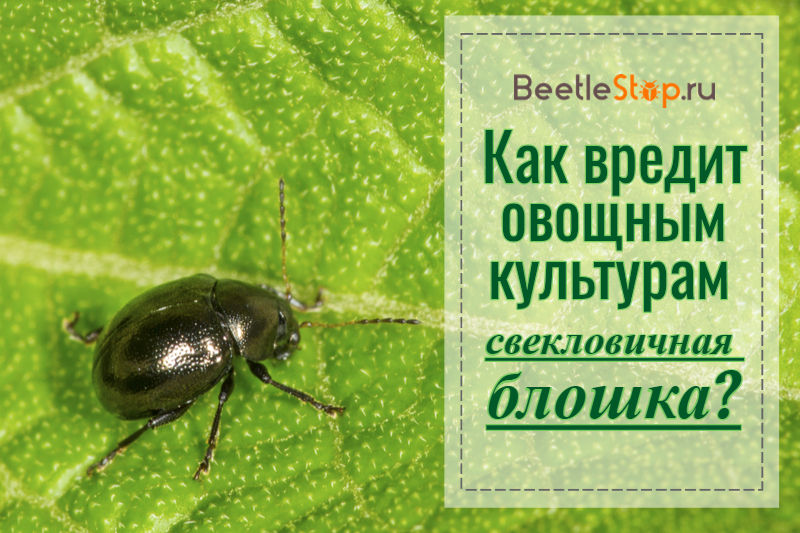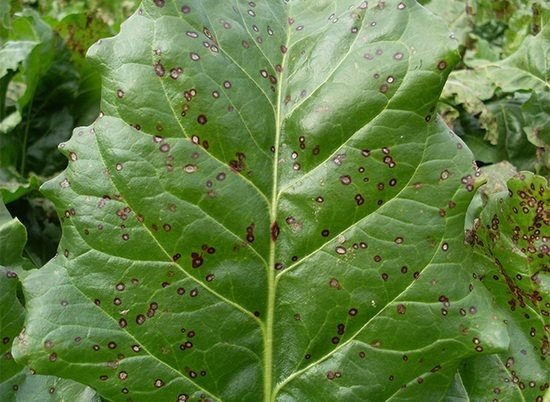Holes on beet leaves are a beet flea.
A large family of leaf beetles includes many species that are harmful to agriculture. Beetroot flea is a small beetle from the subfamily of earthen fleas. There are several related species that damage vegetable crops in different regions. In dry weather with mass reproduction, insects cause serious damage to young beet seedlings. To protect the fields, special agrotechnical measures have been developed, systemic insecticides are used.

Beetle Description
Beetroot fleas are a group of several species of insects that look very similar to each other. The beetles belong to the leaf beetle family, the subfamily earthen fleas, the genus hatoknema (Chaetocnema). Characteristic features of insects:
- body size - 1.5-2.4 mm;
- body shape is oval, convex;
- black color with various shades of copper or green;
- antennae dotted, composed of 11 segments;
- hind legs hopping, characterized by thickened hips.
Information. Together with beetroot hatchem-beetroot, beet seedlings are harmed by adult beetles of the stem bread flea. Larvae of this species feed on cereals (wheat, barley, rye).
Types of Fleas
Common beetroot flea (Chaetocnemahortensis) or buckwheat hatchem
The beetle is dark bronze, oval in shape. Size 1.9-2.4 mm. Elytra in longitudinal rows of points. The convex shield is covered with fine punctures. The tibia of the middle and hind limbs on the outer edge have a deep cut. Adults hibernate in the vegetation of forest belts, bushes, fields. In cold regions, they are buried in the soil to a depth of 20-25 cm. The summer begins in April, the first food occurs on the weeds of the buckwheat or blotch family. Insects massively move to the fields when two leaves of beet appear. Initially, the extreme crops are attacked, then they are spread throughout the field.
Reproduction begins in May-June. The female makes masonry in the soil near the roots of buckwheat crops on which the larvae feed. Buckwheat ketoknema occurs everywhere, damages beets, hops, and feeds on cruciferous plants in drought.

Southern beetroot flea (Chaetocnemabreviuscula)
The body of the beetle is copper-bronze with a greenish sheen. The shape is ovoid, size 1.8-2.3 mm, males are smaller than females. Antennae and legs with a reddish tinge. On the forehead about the eyes 3-5 points. Elytra covered with grooves. The hips on the hind legs are thickened. The female lays up to 50 eggs in the soil next to the gauze, amaranth, or beets. The eggs are oval, translucent. Larva 4.5 mm long. In hot weather, when the soil is heated to 40 °, the beetles leave the beet fields and move to meadows with dense grass.

Western beetroot flea (Chaetocnematibialis)
The pronotum and elytra are bronze with a greenish tint. Antennae 11-segmented. The color of the extremities is tan. Scutellum at small points, elytra covered with even rows of large points. Hatoknema western distributed in the south of the European part of Russia. The development cycle is similar to an ordinary beetroot flea.
Distribution area
The distribution area of beetroot fleas covers all regions where their beetroot feed plant is grown.Beetles are found in southern Russia, in Kazakhstan, Central Asia, Western and Eastern Siberia. Insects live in the west of Europe, in Japan, Korea.
Developmental biology
Overwintered adults emerge from the earth at a temperature of 6–9 °. Until the first shoots of beets appear, the beetles feed on wild herbs. The top layer of the leaf plate is eaten up on the tops. Later, damage turns into through holes. With mass nutrition, plants die. The greatest harm to vegetable crops is done in warm, dry weather. Beetles do not like moisture, they eat less, try to hide from the weather.
Information. Beetroot fleas move in powerful leaps and small hops.
Under favorable conditions, laying eggs by a female takes 2-3 weeks, in the cold season it stretches for several months. Light yellow small eggs are placed in the soil to a depth of 3-5 cm at the roots of fodder plants. Fertility of the female is about 200 eggs. One or two generations develop over a year, depending on climatic conditions. Hatching larvae feed on plant roots. Their development takes 25-40 days. Three ages are changing.
The size of the adult larva is 3.5-4.5 mm. The body is worm-shaped, white. The head is brownish-yellow, legs are brownish. Extremities with developed hips, claw-like legs. At the rounded end of the abdomen are two sharp spines. Pupation takes place in an underground cradle at a depth of 10 cm. The pupa is white, 2 cm long. It develops for 14 days. In the rainy season, in moist soil, up to 75% of pupae become infected with fungal infections and die. A new generation of fleas comes out in early July. Until the first cold weather, they feed on various beet varieties. The crops are not harmed much. For wintering they often fly away to forest plantations.
Malware
In addition to various varieties of beetroot, fleas damage other plants of the blotch family. An ordinary hatchem strongly eats buckwheat, rhubarb, and flax. South hatoknema harms table and sugar beets, swede and turnip. Western hatchem feeds on beets.

Methods of struggle
Fighting field pests with agrotechnical methods; with the mass distribution of pests, chemical treatments are carried out.
Agrotechnical methods
- Timely destruction of weeds in the fields and mowing weed grass along crops.
- Compliance with crop rotation.
- Conducting events ensuring friendly shoots.
Chemicals
Before sowing, seeds are recommended to be treated with insecticides. At the plants, preparations based on carbofuran are used. If 2-3 beetles are found on seedlings, it is necessary to spray one of the preparations: Actellik, Kinmix, and Fury.

